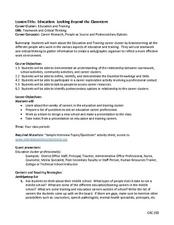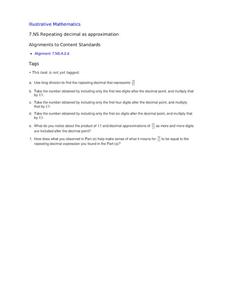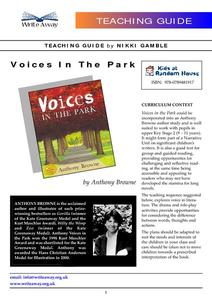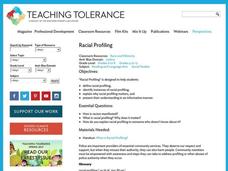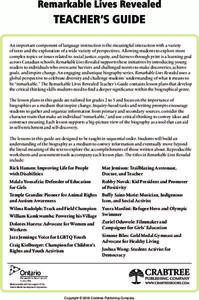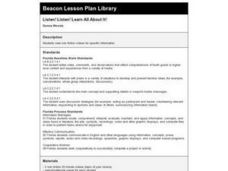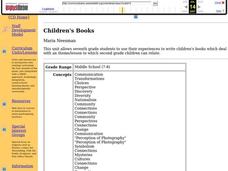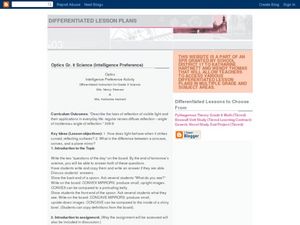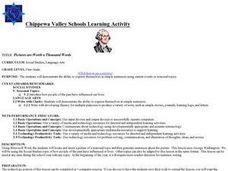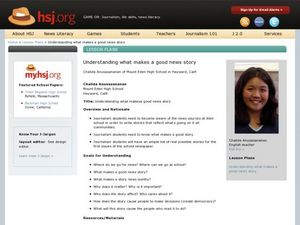Curated OER
What Portraits Reveal
Students examine how portraits can tell us more about people of the past than just what they looked like. They compare three portraits of U.S. Presidents, analyze portraits of Americans from the Revolutionary War, and write a report on...
Curated OER
Exploration of "Pillbugs"
Fifth graders define vocabulary terms, identify the characteristics of a pillbug, and create a dichotomous key. Then they examine the pillbugs and make observations and record these observations. Finally, 5th graders observe specific...
Curated OER
The Dragon of Brog: Stereotyping and Discrimination Social Justice Lesson Plan
Stereotyping and discrimination are explored in this social justice activity. Students listen to the book Dragon of Brog, in which mythical characters experience discrimination. Then, they sculpt a magical character out of plasticene...
Curated OER
The Sum of Our Integer Intelligences
Young mathematicians explore integers. They review adding integers through engaging in mathematical labs. Each lab station is designed to reflect one of the multiple intelligences. Resources for all activities are provided.
Curated OER
Education: Looking Beyond the Classroom
To better understand what it takes to work in the field of training or educating, learners first explore the education career cluster. After they research the cluster, pupils write questions for a guest speaker. This speaker can be from...
Alabama Department of Archives and History
A College Student's Perspective on WWI
Some things remain the same, such as the world being on the brink of war, or college attendees writing home requesting money. As part of their research into events that led up to President Wilson's declaration of war on Germany, class...
BioEd Online
Muscles and Bones in Space
Being an astronaut takes not only high mental acuity, but also a high level of physical fitness, especially for those who spend a long amount of time away from Earth, such as the astronauts serving on the International Space Station....
Baylor College
Energy for Life (Energy from Food)
Energy comes in many forms, but how do living things get the energy they need to survive and thrive? In a simple, controlled experiment with yeast, water, and sugar, groups make observations about how yeast reacts with water alone, then...
Curated OER
Repeating Decimal as Approximation
You are used to teaching repeating decimals with bar notation that keeps us from writing that number over and over again; now teach what the over and over again represents. This activity allows your mathematicians to explore the infinite...
Write Away!
Voices In the Park
Explore the impact a narrator's point of view has on a story with a reading of the children's book, Voices in the Park by Anthony Browne. Written in four different voices, the story is told and retold from different perspectives to...
Super Teacher Worksheets
Find Somebody in This Class Who....
Here is a fun and simple ice breaker in which your young learners will interview their classmates to discover which ones have had similar interests and experiences.
Barnstable Public Schools
Math Relay Races
A plethora of activities make up a cross curricular choice page filled with math games—relay races, dice, and crossword puzzles—a survey challenge equipped with data organization, graphing, a quicksand recipe, Hula-Hoop activity to...
Teaching Tolerance
Racial Profiling
Racial Profiling. Class members chart what they know and what they want to know about this hot-button topic.
University of Minnesota
Beautiful Brain: Brain Inspiration
"Neuroscientists consider Cajal as important to their discipline as Einstein is to physics." The first of four lessons has scholars view Santiago Ramon y Cajal's drawings of neurons. They reflect and respond to the art through writing...
Institute for Humane Education
In Your Face: Reclaiming Billboards
Ads here, ads there, ads everywhere—but what do they communicate? Pupils discuss this topic and develop a list of personal values. They then work as creative directors at an advertising firm to create billboards that reflect community...
Crabtree Publishing
Remarkable Lives Revealed
Six lessons make up a unit all about biographies. Scholars read about a remarkable life while taking notes and identifying characteristics of the biographical genre. Readers examine the tale's obstacles, accomplishments, and sequence of...
Curated OER
The Time I Got Lost
Third graders go through the writing process but substitute paper and pencil with the computer to create a story about "The Time I Got Lost".
Curated OER
Listen! Listen! Learn All About It!
Fourth graders view non-fiction videos. They write questions that can be answered with information in the video. Every 10 minutes the video is stopped and the class discusses the questions.
Curated OER
What Kind of Student Do You Want to Be?
Third graders write an essay which answers the question, "What kind of student do you want to be?"
Curated OER
Children's Books
Students explore daily dilemmas students face. They write and illustrate a story book dealing with one dilemma. Students write reviews of their books. They read their books to second grade students. Additional cross curriculum activities...
Curated OER
Intelligence Preference
Eighth graders describe how light behaves when it strikes a surface. In this physics lesson, 8th graders investigate how the different types of mirrors reflect light. They work with their chosen group on a task they selected.
Curated OER
Pictures Are Worth A Thousand Words
First graders write simple sentences based on historical figures they find in pictures. In this simple sentences lesson plan, 1st graders search for pictures in Microsoft Word and write simple sentences about them. These pictures and...
Curated OER
Understanding What Makes a Good News Story
Students explore the news sources at their school in order to write stories that reflect what's going on in all communities and to identify what makes a good story. In this news writing activity, students journal about what makes a good...
Curated OER
Family Stories
Learners use dance to better understand the writing process. In this interdisciplinary lesson, students use their critical thinking skills to connect dance with writing. Learners use thinking maps to follow the writing process, write a...






